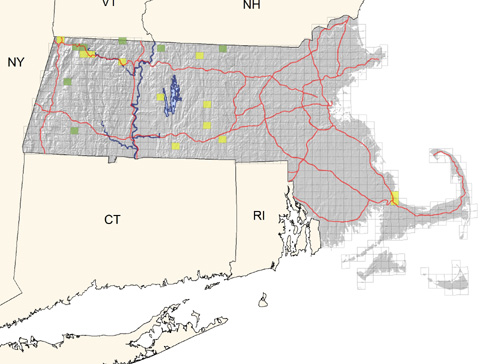Breeding Bird Atlases (BBA)
Find a Bird - BBA1
Breeding Bird Atlas 1 Species Accounts
Sharp-shinned Hawk
Accipiter striatus
State Status
Special Concern
Egg Dates
May 3 to June 24
Number of Broods
one; may re-lay if first attempt fails.

The Sharp-shinned Hawk, the most frequently seen accipiter in Massachusetts, is observed primarily during migration and in the winter, when individuals may be seen preying on small birds at bird feeders. Very feisty on migration, the Sharp-shinned Hawk is often seen harassing other hawks or engaging in aerial “dogfights” with others of its kind.
The Sharp-shinned Hawk breeds primarily in the northern and western mountain forests of North America. In the Commonwealth, it is our most secretive and least common nesting accipiter. No “confirmed” breeding sites were found during the Atlas survey, though six “probable” sites were reported. At least 7 nests have been subsequently documented. Although it is by no means common, the Sharp-shinned Hawk is almost certainly more numerous as a breeder than these results indicate, especially in the western half of the state; this hawk’s shy, retiring behavior while nesting makes it difficult to find or to identify its breeding sites. The female will often sit quietly on the nest when human intruders approach or will silently vacate the nest area until they leave. Occasionally, some individuals may harass humans within a distance of 150 feet of the nest, though their small size makes them less intimidating than the much larger and more demonstrative Northern Goshawk.
The Sharp-shinned Hawk was apparently a more abundant breeder in Massachusetts during the nineteenth century. Its decline as a breeding species has been attributed in large part to the deforestation that occurred late in that century and early in the twentieth century. The gradual maturation of Massachusetts’ forests has not yet precipitated a strong resurgence of the species. It is believed that the Sharp-shinned Hawk population in northeastern North America may have declined during the first half of the 1990s, possibly due to pesticide contamination, although data is incomplete.
The spring migration period extends from mid-March to mid-May, with the largest concentrations, primarily immatures, passing through from late April to early May. Resident birds usually return in late March and April, with the males returning first.
The male establishes the territory, usually in coniferous or mixed coniferous and deciduous woods. They prefer relatively open rather than deep forest, or else large wood lots with scattered secondary growth. Historically, Sharp-shinned Hawks in the state tended to prefer to build their nests in White Pines. Nests found subsequent to the Atlas period indicate a preference for Red Spruce and occasionally White Birch. Nests are usually located 10 to 60 feet high against the trunk or in a notch of the tree, the dense foliage providing protection from predators and the sun. Old nests are rarely reused, but the same stand of trees is often selected. The nests may be up to 2 feet in diameter and are neatly built of sticks, twigs, and occasionally other materials. Both sexes may gather nesting materials, but the female usually does most of the nest building. Birds may breed in immature plumage; nesting pairs are solitary.
Following the rarely observed courtship flights that take place above and beneath the canopy, three to eight eggs are laid, the number depending on the availability of prey. Four to five eggs is the typical number. Eggs are variable in size and shape, and the color ranges from white to bluish or greenish white with brown, lilac, and even lavender markings. Incubation lasts 30 to 35 days and generally begins with the laying of the third or later egg. Both sexes may incubate, but the female does much the larger share. Nestlings take 21 to 25 days to fledge and may remain with the adults up to a month or more after fledging. Hearing the food begging calls of the young shortly before or after fledging is often the easiest way to locate a nest site. Food items include primarily small birds, although insects, small mammals, and even amphibians may be taken during times of food shortage.
The fall migration is the best time to see Sharp-shinned Hawks in the state. The young migrate primarily during September and early October, with smaller numbers of adults predominating from mid-October into November. The vast major- ity migrate to the southern United States and, to a lesser extent, Central America, with small, but variable numbers wintering in the state. Many people are probably familiar with the Sharp-shinned Hawk as the most common avian predator at winter bird feeders, where an individual, particularly an immature, may exploit flocks of sparrows, chickadees, and other birds. It has been suggested that wintering Sharp-shinned Hawks may be most numerous when flocks of winter finches such as Pine Siskins or redpolls are abundant (Griscom & Snyder 1955).
The Sharp-shinned Hawk is listed as a species of special concern in Massachusetts.
Map Legend and Data Summary
Atlas 1 data collected from 1975-1979


Note: rare and inconspicuous in coniferous woodlands of central and western areas; possibly overlooked
Paul M. Roberts



